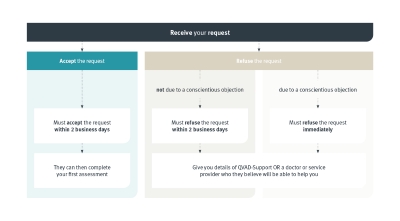Making a first request for voluntary assisted dying
If you decide you want to access voluntary assisted dying you must make a first request to a doctor. This is the first of 3 requests.
Your request must be:
- clear and unambiguous, so your doctor knows exactly what you are asking
- made by you and not by another person on your behalf.
Your request can be made verbally or by other means of communication such as gestures.
Your request should be made to your doctor during a medical consultation. Your appointment should be for a long consultation. This appointment can be in person or via telehealth. To help your doctor prepare for the appointment you should tell them that you plan to discuss voluntary assisted dying.
Your first request should be clear, so your doctor understands what you are asking, for example:
- 'I would like to make a first request to access voluntary assisted dying.'
- 'I would like you to help me die.'
Acceptance of the first request
If your doctor accepts the first request, they become your coordinating doctor, also known as your ‘coordinating practitioner’. The coordinating doctor supports you through the process. To be a coordinating doctor, a doctor must:
- meet eligibility criteria
- have completed mandatory training, and
- been authorised by the Queensland Health Chief Medical Officer.
Find out more about the roles healthcare workers have in the voluntary assisted dying process.
Your doctor can accept your first request before completing the voluntary assisted dying mandatory training, however, they must have completed the mandatory training before starting your first assessment.
If your doctor accepts your first request, they will:
- ask questions to understand why you want to access voluntary assisted dying
- ask questions to understand your knowledge of palliative care and treatment options available to you
- provide you with information the eligibility criteria, the process and the timings
- ensure you understand what is involved in the voluntary assisted dying process
- make sure you know that you can stop the process at any time
- give you the Acceptance of the First Request: Queensland Health Approved Voluntary Assisted Dying Information
- explain the role of the Queensland Voluntary Assisted Dying Support Service (QVAD-Support)
- explain what happens next
- make a note in your medical record.
Following the acceptance of your first request you will need to make an appointment for a first assessment.
Refusal of the first request
Not all doctors provide voluntary assisted dying
Your doctor can refuse your voluntary assisted dying request because they:
- are not eligible to be a voluntary assisted dying practitioner
- may have a conscientious objection, this is the right to refuse to provide voluntary assisted dying due to personal reasons or beliefs
- will not be available to help you through the process, for example, they will be on leave
- are otherwise unable to perform the duties of the role.
If your doctor refuses your request, they will:
- tell you that there are other doctors or health service providers who may be able to help you with your request
- give you either:
- information about another doctor or service provider who they believe is likely to be able to help you with your request
- the details of QVAD-Support, who will help you find a doctor who can consider your request
- tell you the reason for their refusal.
If the reason for refusing the first request is a conscientious objection, the doctor must immediately inform you of this. Otherwise, your doctor must inform you of their acceptance or refusal within 2 business days after you make a first request.
This flowchart outlines the timelines a doctor must inform you of their decision




